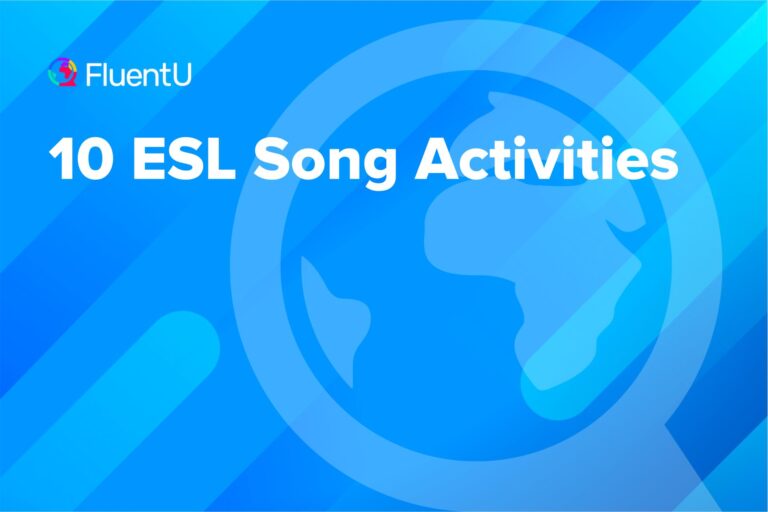39 Fun ESL Games and Activities

Getting playful with the English language is a great way to push your students’ creativity and show them how useful their knowledge really is.
And the best way to do that is with fun ESL games for the classroom!
There’s nothing like a room full of friendly competition and laughter to make learning more fun.
Read on below for 39 ESL group activities that will get your students engaged and practicing their English. We’ll also discuss grouping strategies for effective gameplay.
Download: This blog post is available as a convenient and portable PDF that you can take anywhere. Click here to get a copy. (Download)
ESL Vocabulary and Spelling Games
1. Vocabulary Showcase Game Show
Best for: Big groups; communication
In the Vocabulary Showcase Game Show, students will learn new words through firsthand communication. Students must explain the chosen word to their teammate without saying the word.
All you need is a whiteboard, a timer and a list of vocab words that students already have a fairly good grasp on.
How to play:
- Review the vocabulary words if needed or desired.
- Divide the class into two teams. Team A will choose their first contestant to start the game.
- Student A from Team A will stand with their back to the whiteboard.
- The teacher writes a vocabulary word on the board and starts the clock. Two minutes per word is best practice in order to get multiple students involved.
- Once the clock starts, Team A will do their best to describe the vocabulary word. They cannot use the word or spell it out.
- If Student A guesses the correct word, Team A gets a point.
- Switch. Now Team B will send up their first member to guess a new vocabulary word. Same rules apply.
- At the end, the team with the most points wins.
2. How’s Yours?
Best for: Small groups; beginners
This ESL game will have students guess the object everyone is talking about by asking the eponymous question: “How’s yours?”
You don’t need anything to play this game, though it may be helpful to have some slightly more challenging words to offer your students if they’re struggling as the game leader.
How to play:
- Select a student to go first (or ask for a volunteer).
- This player is sent into the hall or somewhere out of earshot.
- The teacher will be game leader first. Pick a body part, type of clothing, common person or common object and inform your students of the secret word. Possibilities might include: shoes, mouth, car, mother, teacher or ring.
- The first player comes back into the room.
- The player’s goal now is to figure out what the secret word is by asking each student, “How’s yours?” Each student should respond in just two or three words. Remind them—no pointing!
- Once the first player has an answer from each student, they must guess what the object is. Use points or rewards as desired.
- Continue by having the first player become the game leader; a new student will go into the hall and be the guesser.
Tip: Pick the shy students early so they can play more confidently after they’ve been the guesser.
Example:
The secret word is “teeth.”
When the player asks their question (“How’s yours?”), students might respond:
- Dirty
- Minty
- Smelly
- Big
- Crooked
3. Fly Swat
Best for: End of the lesson; practicing synonyms/antonyms/homonyms
This fun ESL game is a race to the board! Students will compete to be the first to find the answer and swat it with their fly swatter.
You’ll need two fly swatters, PowerPoint and a projector. You can substitute the PowerPoint/projector combo for a simple whiteboard, but just know you’ll probably have to do some rewriting throughout the game. It also helps to prepare your questions ahead of time.
How to play:
- Using PowerPoint, prepare a slide with vocabulary words scattered everywhere.
- Split the class into two teams.
- If needed, inform students they can only swat one word on their turn to make sure they really think about their answer.
- In turns, each team sends up one person to the board. They are each given a fly swatter.
- Read a question/definition aloud. The first student to swat the answer on the board wins the round!
Feel free to ask the same question more than once (repetition is part of the learning process!).
4. Shiritori Showdown
Best for: Warm ups; quick thinking
The word shiritori is Japanese for “chicken’s behind.” Each student will use the last letter of the previous word to make a new one. If the timer goes off—you’re out!
It can be played in any sized group, and the only thing you need is a timer.
How to play:
- Choose a student to start the game.
- Enter the time on the timer, perhaps 1-2 minutes depending on the class. Begin.
- The chosen student starts the game by saying any word they’d like.
- The next student has to say a word that begins with the last letter of the previous word.
- Play continues until the timer goes off.
- The student who failed to think of a word may have to write on the board, or elimination can continue each round until there’s one winner.
Example:
(Teacher sets the timer to 30 seconds.)
Teacher: I’ll start. Moist.
Student 1: Umm… Towel.
Student 2: Hmm… Like.
Student 3: Like. Like. Like. Umm…
(Timer beeps. Student 3 is out.)
5. Hangman
Best for: All lesson types
Hangman is an oldie but a goodie. Students must guess the letters of the alphabet to figure out a word or phrase before the hangman’s drawing is complete.
All you need is paper and pencils—or just a whiteboard if you want to play as a class. Let students take turns picking the word and drawing the blanks. Encourage using new vocabulary words so they can practice spelling.
(I found the original drawing inappropriate for younger students, so I usually drew my stick figure on the plank of a ship over a sea of monsters. As a bonus, students loved being chosen to draw one of the sea monsters on the board before the game began!)
How to play:
- The leader draws the setup and the blanks for the chosen word or phrase.
- Students take turns guessing letters of the alphabet to fill in the blanks. Correct guesses are written into place in the blanks. For each incorrect guess, the leader adds one body part of the “hangman” to the drawing.
- If the guessers get the correct word first, they win. If the picture of the person is completed first, the leader wins.
- Switch out the leader and play again!
For extra fun, watch a video clip first, then play Hangman using only words from the clip. And for extra practice, at the end of each round, ask students to talk about the definition of the uncovered word or try to use it in a sentence.
6. Jeopardy
Best for: Big groups; comprehensive review; critical thinking; speaking skills; teamwork
Jeopardy is another classic English classroom game that helps students build their confidence. You’ll set it up just like the TV show: a big board with answers and points, where students will need to provide the missing question.
For Jeopardy, you’ll need PowerPoint or an internet connection with an online jeopardy board, plus a projector.
How to play:
- Prepare a jeopardy board with questions on the chosen subject matter. You can do this on PowerPoint with a premade template, or use Jeopardy Labs for easy set up.
- Assign point values that align with the difficulty of each question to ensure a fair distribution of points. Don’t forget to include a “Daily Double” for extra fun!
- In class, split the students into even groups of four, five or six. Adjust the number according to the number of students in the classroom. For the ideal playing situation, there should be 4-6 groups.
- After the class has been split into groups, the first group chooses a subject and point value.
- Read the corresponding question aloud. Anyone in class can raise their hand to answer the question.
- The first hand up gets to answer. If they’re right, their group receives the points and gets to pick the next question. If they’re wrong, subtract the points from that team; another group gets a chance to answer.
- The group with the most points at the end of the game wins!
Note: You may want to select a spokesperson for each group to keep chaos to a minimum. Rotate the spokesperson every few turns so everyone gets the opportunity to speak.
7. Backdraw
Best for: Big groups; all lesson types; spelling and vocabulary skills
Backdraw is one of the most popular games in classrooms and works for any level. In this game, the students aren’t allowed to talk.
How to play:
- Put the students into equal teams and line them up facing the blackboard. All the students must face the blackboard and cannot turn around.
- Inform the students that they cannot speak during the game, or their team is out.
- Give a word to the last student in each team (the student furthest from the blackboard). Usually, it’s best to write the word down and have them read it, so nobody can overhear it.
- When the teacher tells them to begin, the last student must silently write the word on the back of the student in front of them. Once they’re done, the next student then writes the word they “felt” on the student in front of them. This continues until the first student has the word.
- The first student goes to the blackboard and writes the word, spelled correctly.
- The first team to complete the task correctly is the winner.
8. Sparkle
Best for: Big groups; teambuilding; from beginner to advanced students
This game focuses heavily on spelling and team skills, and it’s a great way to cement the difficult words on your vocabulary list.
How to play:
- Divide the students into teams. The number of teams doesn’t matter.
- Approach the first team and give them a word to spell. The following steps should be conducted with each team, one at a time. The other students may listen, or practice silently spelling the words, but there shouldn’t be talking from the other teams.
- The first student on the team may only give the first letter.
- The next student says the second letter, and so on.
- Once the word is complete, the next student must repeat the whole word, to signal they’re done spelling.
- Each correctly spelled word earns the team a point.
This game can also be made more or less challenging by choosing higher or lower level words. Also, for more advanced students, they can be asked to spell the word backward.
9. Squat
Best for: Beginners; big groups; pronunciation practice
This game is an excellent way to use physical activity in the classroom while also engaging the brain in language learning.
How to play:
- Line up the students in the front of the classroom. If you have a large classroom, have them line up in groups of six students at one time. While each group of six students plays, the other students are encouraged to watch and be engaged in the game.
- Assign each student a different word. Encourage them to repeat the word back to you.
- Now the game begins. The teacher (or a designated higher-level student) must say one word at a time.
- The student who is assigned that word must repeat it back and do a squat right away. A deep squat means they hold their arms out in front of them and bend their knees until the thigh bones are horizontal.
- If the student forgets, says the word incorrectly or is extremely late, they’re out and must sit down.
This game can be made more challenging by having the teacher speak faster, or having the students say and spell the word.
ESL Listening Games
10. Flash Art
Best for: Creative students; reading comprehension practice
You’ll give your students scenarios in English and let them create quick interpretations through drawing. This ESL game offers a break from tough topics and traditional book learning.
For this game, you need plenty of paper and drawing materials like colored pencils, markers or crayons.
How to play:
- Decide whether you want to work on students’ listening comprehension, reading comprehension or both.
- Say a scenario out loud or write it on the board.
- Students will transcribe or copy the scenario on a piece of paper.
- Give students an allotted amount of time to draw out the scenario on their paper.
- At the end of the session, students may present their drawings. You may also have them vote on their favorite piece for each scenario.
Note: You may only have time to do one or two Flash Art scenarios per session.
Examples:
- There is a man running in a park. He is being chased by a dog.
- A mother and daughter are baking cupcakes.
- Many cars are stuck in traffic due to rain.
11. Find Someone Who…
Best for: Big groups
Students must be quick to listen and comprehend the spoken statement, or they’ll end up in the middle where they’ll have to come up with the next statement themselves.
The teacher can have a prepared list of “Finds,” or students can make up their own in this fun ESL game.
How to play:
- Have everybody begin in a big circle.
- The teacher calls out something like: “Find someone who… is wearing glasses.”
- Everyone runs to grab the hand of a person wearing glasses. Assuming each student has two hands, only two people can be partnered with each glasses wearer.
- Whoever is left without a hand to hold stands in the middle.
- Select a student in the middle to call the next statement.
Examples:
The possibilities are endless! Students can find someone who:
- is wearing red.
- has words on their shirt.
- can curl their tongue.
12. Telephone
Best for: Big groups; speaking skills; pronunciation practice
Telephone is another classic. Students will whisper a given phrase down the line. The last person will announce the likely convoluted sentence to the class for everyone’s amusement.
This ESL game is easy to play—no materials needed!
How to play:
- Have all of the students sit or stand in a straight line or a circle.
- Make up a phrase or sentence and whisper it in the first student’s ear.
- That student then whispers the phrase to the next person, and so on and so forth.
- If a student would like the phrase repeated to them, they can say “Operator!” This can only be done once per person.
- The last person to hear the phrase will repeat it out loud. It’s always funny to see how different the phrase turns out!
To make this game competitive, split the class into two teams and see who gets closest to the original phrase.
13. Song Puzzle
Best for: Small groups; sentence order review; listening practice; speaking skills
Song Puzzle is a fun ESL classroom game that will get your students jamming along to music. You’ll play a song while they arrange the lyrics in the proper order.
To set up this game, select an appropriate song (if you have young students, check out this resource for some suggestions). Print a copy of the lyrics for each small group in your class. Cut each one into strips to create a complete set of lyrics for each group.
How to play:
- Make sure all your materials are prepared before class begins (the song is printed and cut into strips, and you have enough sets for each group).
- Separate students into small groups of two or three. Give each group a complete set of lyric strips.
- Play the song. Groups will try to organize the lyrics into the correct order.
- Continue replaying the song until a team is done. Check the order of their lyrics.
- The first group to organize the lyrics correctly wins.
- Continue playing until all groups have figured out the correct order of the lyrics.
- Use the lyrics to sing the song aloud as a class!
Depending on the song you choose, you can use the lyrics to teach a specific set of vocabulary or a grammar concept. For example, check out this list of songs with passive voice in the lyrics!
ESL Games for Communication and Teamwork
14. Question Volley
Best for: Big groups; speaking skills
In Question Volley, students will ask and answer questions on the spot to boost their confidence in responding to questions naturally and quickly.
All you need for this fun ESL game is a small ball! For added fun, you can always change up what you’re tossing around: a potato, a soccer ball, a frisbee, etc.
How to play:
- Tell students the topic so questions remain relevant.
- Teacher starts! Have a student toss you the ball and ask you a relevant question.
- Answer the question.
- Toss the ball to a different student. Ask them a question.
- They will answer, and then pass to another student and ask them a question.
- Continue passing, asking and responding until everyone’s had a turn.
Make sure to encourage quick questions and answers to give this a real-life feel.
Examples:
If your lesson topic is sports, some questions might be:
- What sports do you play?
- What sports do you like to watch?
- Who is your favorite athlete?
For more example questions, try this resource—and check out our dedicated post on ESL movie activities.
15. My Name is X, and I Like X
Best for: Combining with a vocabulary lesson; big groups; speaking skills; memory recall
Students will introduce themselves and something they enjoy. Depending on the level of your class, they may learn introductions, transitive verbs and first- and third-person sentence structures.
You don’t need anything for this game, but note that the more randomly you call on students, the more likely they’ll pay attention to others’ responses instead of counting how many more turns until they have to participate.
How to play:
For beginners:
- Sit in a circle with your class.
- Introduce yourself using this format: “My name is X, and I like X.”
For example: “My name is Mr. Smith, and I like to read.” - Have the next student introduce themself using the same format.
- Continue until every student has had a turn.
For more advanced students, include memory recall. Ask students to introduce themselves and the previous student. That is: “His/her name is X, and he/she likes X. My name is X, and I like X.”
The most advanced way to play this game is to include questions, like so:
- Pick a student, either the next in a circle or at random.
- Ask them: “What’s your name? What do you like?” and let them respond.
- Introduce them in the format: “His/her name is X, and he/she likes X.”
- That student will now choose a classmate and ask them the questions.
- The student who asked the questions must introduce their classmate using the answers provided.
- Continue until each student has asked questions and introduced someone.
16. Reporter
Best for: Listening comprehension; conversation practice; speaking/writing skills
In Reporter, students will ask their partner questions in the form of an interview. You may ask them to present or submit their partner’s response in writing.
If you choose to focus on writing practice, you’ll need paper and pencils. Otherwise, simply have some sample interview questions prepared to get the class started with this game.
How to play:
- Brainstorm questions for 5-10 minutes, either individually or as a class.
- Have students pair up.
- During an allotted amount of time, students will ask their partner questions.
- Students may need to write the responses, take brief notes or simply try to remember the answers.
- After the time is up, switch the role of reporter and interviewee.
- At the end, students may present their partners to the rest of the class using the answers provided during game time. Or, students can hand in their interview notes.
You can also turn this into a more elaborate game by assigning the interviews as homework.
In that case, have students present their partners to the class without giving the identity of the partner. The class has to guess who the person is based on the presentation.
17. Secrets
Best for: Quiet/lethargic classes
Students will use questioning skills to work out whose secret they know. Get them moving around the room and chatting with this fun ESL classroom game.
You’ll need some slips of paper and something to hold them in—a hat or a small bowl will do nicely.
How to play:
- Ask each student to write down a secret on a piece of paper. Check that the secrets are written down correctly, but don’t betray students’ secrets to their classmates!
- Have each student fold their paper and put it in a hat.
- Each student will then draw a secret from the hat.
- Once each student has a secret, they will walk around the classroom asking other students questions to find out whose secret they have. They can’t directly say what’s on the paper!
Example:
The secret says, “I have five cats.”
The person holding the secret might ask a classmate:
- Do you like animals?
- How many animals live in your house?
18. Find a Partner
Best for: Big groups; speaking skills; combining with a vocabulary lesson
In this ESL game, you’ll give students a category. They’ll write their favorite thing in that category on a piece of paper. Then they’ll search for someone who wrote the same thing—without actually using any of the words they wrote down!
All you need for this one is some small pieces of paper.
How to play:
- Decide the topic (books, food, movies, etc.). Make sure it’s something that students can talk about in some detail.
- Each student writes down their favorite book (or food, movie, etc.) on a piece of paper and hides it in their pocket or textbook.
- Without using the words they’ve written down, students then go around the room, asking their classmates questions.
- Students who think they’ve found a classmate with the same answer can sit.
- Once everyone’s discovered a partner or once the allotted time is up, students reveal their papers to each other.
To make sure this game is working as intended, the teacher must moderate effectively. Walk the room to ensure students are practicing proper English. Correct them as needed based on topics you’ve covered in class.
19. What Sweet Treat Am I?
Best for: Beginner and intermediate students; speaking practice
Students will take turns asking questions to figure out what sweet treat they are in this fun ESL classroom game.
For this one, you’ll need tape and as many kinds of candy as you have students in class (so, 10 students means 10 different types of candy). Make sure it’s candy they’re familiar with.
How to play:
- Tape a candy wrapper to each student’s back.
- Put the students in a circle.
- Tell students how many questions they can ask before they’ll need to make a guess, and decide what will happen if they get it right/wrong (points, guess again, player is out, etc.).
- Select someone to go first.
- The first player stands up and turns around so everyone can see their candy wrapper.
- The player can ask the group yes or no questions to get clues about their candy.
- After the set number of questions, the player must guess.
- Continue until all sweet treats have been guessed and revealed.
Example:
The standing player might ask some of the following questions:
- Is it red?
- Does it taste like strawberries?
- Does it have chocolate?
ESL Speaking Games
20. Who Am I? What Am I?
Best for: Advanced students; practicing asking questions
This is a slightly more advanced version of the “What Sweet Treat Am I?” activity. It can be modified to include writing if you ask the students to create the cards, rather than doing it yourself.
How to play:
- Before beginning the activity, you may want to brainstorm the types of questions that will help students figure out their cards.
- Using sticky notes or index cards, list common household or school-related objects on each one.
- Have each student pick a card without looking at what it says.
- Have them stick it to his or her own forehead.
- Students then ask their fellow students yes or no questions in order to figure out what their card says.
For more advanced students, cards can list literary characters, book titles or even idioms. Another option is to keep all of the cards related to one theme, like health words, clothing, colors or even slang.
21. Question Master
Best for: Experienced speakers; creative thinking
Question Master helps your students figure out what to ask in a given situation. Set up the scenario and let them ask away!
All you need for this game is a timer. Any amount of people is good, but note that this ESL game works best with more experienced speakers who are comfortable creating sentences on the fly.
How to play:
- Choose a scenario for the class, like at a café, at the airport, or even on a date.
- Set the timer. Begin.
- Each student must ask a question relevant to the scenario. Encourage creativity with this one!
- Continue until the timer goes off. The student is out or the game is over.
Example:
(Teacher sets the timer to a minute and thirty seconds.)
Teacher: Okay, the scenario is at a shop. Go!
Student 1: How much is this?
Student 2: Do you accept credit cards?
22. Time Trials
Best for: Individual students
Instead of racing against others, students are trying to get their own personal best time for English speaking. They’re aiming for speed and precision.
While you could do this with an ESL class, it’s particularly helpful for individual learners. You’ll just need a topic and a timer that starts from zero.
How to play:
- Select something for the student to read/say. This could be anything! A passage in a book, a set of statements, etc.
- Start the clock from zero once the student starts reading/speaking.
- When the student is done, stop the timer.
- Tell the student their time.
- Give them tips on how to improve their speaking speed.
- Have them practice, either in class or out, until they get to a more natural time.
Example:
Teacher: Okay, tell me your name, age, where you’re from, and what you do. Ready? Go! (Starts timer.)
Student: My name is… (continues talking)
(Teacher stops the timer when the student finishes.)
23. Balloon Truth or Dare
Best for: Outgoing students
This is a slight twist on the classic truth or dare. Inside balloons are truths (personal questions) and dares (silly actions), which students must complete in front of the class.
You’ll need balloons (at least enough for each student in the class) and slips of paper, as well as truths and dares. Feel free to adapt statements using vocabulary and grammar suitable for the level you’re teaching.
How to play:
- On slips of paper, write student-friendly dares and questions. Make sure they’re things that most students would be willing to do and answer.
- Put each slip of paper inside a balloon and blow it up. You may want to color code (red balloons = dares, blue balloons = truths), or let it be random.
- Scatter the paper-filled balloons around the room.
- Select a student to go first. They will pick a balloon and pop it, then read their truth or dare aloud before completing it.
- Continue having students choose a balloon, pop it, read the prompt and complete the task until everyone has gone.
A small tip: You may want to start with your more outgoing students. But don’t let your shy students be last either–try to call them out around the middle to help manage their anxiety.
Examples:
For some possible dares, you might write:
- Do a popular dance.
- Sing a class song by yourself.
- Pretend like you’re riding a horse.
- Snore or snort.
And for some possible truths, you might write:
- What did you look like when you were 10 years old?
- If you could live anywhere in the world, where would you live?
- When you were little, what did you want to be when you grew up?
24. Word Warm Ups
Best for: Warm ups; grammar review; creative thinking
In Word Warm Ups, students will attempt to use the given English concept in a sentence before time runs out.
You’ll need a timer. If the timer is your phone and you don’t want it passed around the room, you’ll also need a small ball or another easily passable item.
How to play:
- Set the rules for sentence structure. For example, students must make sentences using “should/shouldn’t.”
- Enter a designated time on the timer. Begin the clock and hand the timer/ball to the first student.
- The first student makes a sentence using the grammar construct, then passes the timer/ball to another student.
- Students continue making sentences and passing the timer/ball until the timer goes off.
- You can make additional consequences as desired for the student holding the timer/ball when it goes off.
Example:
(Teacher sets the timer to a minute and thirty seconds.)
Teacher: Okay, so sentences using the phrase, “even though.” Go!
Student 1: Hmm… I like Canada even though it’s very cold.
Student 2: Okay. Even though she’s only 30, she’s too old for me.
Student 3: Hmm, I… umm. Even though, umm…
(Timer goes off. Student 3 is out.)
25. Mayor (a.k.a. Don’t Vote for Me)
Best for: Advanced students; speech-giving practice
Mayor requires both higher English ability and an appreciation of irony. If your class has both, this game may get shy students to take risks and even be a bit silly. Students will run to NOT become mayor.
No materials are needed. Note that you may want to lower the intensity for your shy students by having everyone stand at their desk to speak rather than the front of the classroom.
How to play:
- Explain that you’re going to have a mock election for mayor in your classroom, but it’s a job nobody wants. Each student must convince the class that they should NOT be mayor and why.
- You may need to go first to show the possibilities.
- Select the first student to give their speech. You can set a time limit so no one speaks too much or too little.
- Continue until each student has given their speech.
- The winner is the one who comes up with the best reason not to be mayor, which can be decided by vote. It’s an election, after all!
Example:
“I would hate to be mayor. Do not vote for me. I do not like to be around smelly, old citizens. Children are noisy. Who cares about education?”
26. Reading Race
Best for: Reading class; small groups; reading speed; pronunciation practice
This English classroom game will have students race against the clock to finish the reading passage. The key is that they must do so with no mistakes.
You’ll need a timer and reading material to play, so this game is especially great if your class has a reading text they’re working through.
How to play:
- Provide students with the reading passage you want them to practice. Make sure everyone’s on the correct page.
- Set the time and begin the timer.
- Each student will attempt to read the next sentence (or the whole passage) perfectly.
- If they mispronounce a word or rush through a sentence, correct them. They must start again from the beginning.
- Once they’ve read the given part with no mistakes, it’s the next student’s turn.
- The student who’s reading when the timer goes off is out!
Example:
(Teacher sets the timer to two minutes.)
Teacher: Okay, reading race, page 7. Ready? Go!
Student 1: (Reads passage perfectly)
Student 2: (Reads passage but has an error with pronunciation)
Teacher: (Tells student correct pronunciation) Sorry, reread!
Student 2: (Reads passage perfectly)
Student 3: (Reading but struggling a bit)
(Timer goes off. Student 3 seems to be having some trouble with these games! They’re out.)
27. I Took a Trip to the USA
Best for: Big groups; listening skills; memory recall
This speaking game puts an emphasis on listening, focus and memory-building skills while also encouraging students to recall vocabulary.
How to play:
- Teach the students the speech they must learn for every turn in the game: “I took a trip to the USA, and with me I took…”
- The first student says the sentence, and names an object starting with an “A.” For example, “…and with me I took an apple.”
- The next student must repeat the first word, then add a word that starts with a “B.” For example, “…and with me I took an apple and a banana.”
- Every following student must repeat every word previously said, and add a word starting with the next letter of the alphabet. For example, “…and with me I took an apple, a banana, and a cat.”
- The game continues until a word cannot be named or a word is forgotten.
This is a very flexible game that can be adapted to any classroom. First, be specific on wanting students to use articles and the word “and” before the last word. Also, you can give the classroom a category to follow, such as asking them to name animals or foods.
ESL Games for Creative Thinking
28. Storytelling Memory Game
Best for: Speaking skills; memory recall; vocabulary building; sentence structure review
Together, the class will tell a story out loud by finishing each others’ sentences in this ESL game.
Smaller groups make this game easier, while larger groups will really test students’ memories. No materials needed!
How to play:
- Begin by sitting in a circle.
- The first person (this can be you, but it doesn’t have to be) starts the story with a fragment, such as: “It was a dark and stormy night…”
- The next person in the circle must repeat what the first person said and add a phrase of their own.
- Continue going around the circle until someone messes up. You can start over, prompt them or something else.
- In the end, you could have students write down the story. Or write it on a poster board and hang it up in your classroom for students to remember and get a good laugh!
Example:
Teacher: It was a dark and stormy night…
Student 1: It was a dark and stormy night and no one was around.
Student 2: It was a dark and stormy night and no one was around. Suddenly, there was the sound of…
29. Two Truths and a Lie
Best for: The first class; advanced students; speaking/writing skills; conversation practice
In this game, each student will present three statements about themselves—two are true, and one is false. Their classmates must ask questions in order to determine which statement is the lie.
Two Truths and a Lie only requires a whiteboard (or anything you can write on).
How to play:
- Ensure the class understands the meaning of both “truth” and “lie.”
- You’ll go first as an example. On the board, write two truths and one lie about yourself.
- Tell the class that one of the statements on the board is not true.
- Students may ask you non-specific questions about what you wrote. You may want to give a question limit to raise the stakes of the game.
- Once the questioning is over, students will write down which statement they believe to be the lie.
- You can ask them to share their guesses and why they came to that conclusion.
- Reveal the lie!
- Select a student to take your place. The game repeats until everyone has had a turn.
Example:
One statement says: “I enjoy running every morning.”
Students may ask things like:
- What kind of running shoes do you have?
- What time do you begin your run?
30. Funny Papers
Best for: Writing practice; collaboration; pair or small group play
Funny Papers is a fun ESL game where students are asked to fill in the blank speech bubbles of a comic strip.
Using the Sunday funny papers or some blank comic strips online, white out the text of each character’s speech bubbles or dialogue boxes. Make enough copies for your class.
How to play:
- Give your students an example. Show them the comic strip and ask what they think is happening in the scene. Write some of their responses in the speech or thought bubbles above each character.
- Now, split the class into groups for the activity.
- Hand out the comic strips and let each group create their own Funny Paper.
- Visit each group to offer insight and answer questions they may have.
- Once the comics are complete, students can present them to the class.
31. Dictionary
Best for: Any level; speaking skills; writing skills
If you know the game Balderdash, you’ll recognize Dictionary. One team member will lead the way. Players will guess the definition of a difficult word, and a judge will decide their favorite answer. In the end, someone wins a treat!
You’ll need dictionaries or vocabulary lists (with definitions) for this game. You’ll also need sticky notes for each group and some prize candy.
How to play:
- Split the class into groups of five or six students.
- Give each group a packet of sticky notes and a dictionary/vocab list.
- For each group, select a leader and a judge. (Tip: Try picking the shyest students to steer the groups first.)
- The leader finds a word in the dictionary/on the list that they do not believe anyone else knows. The leader writes the correct definition of the word on the sticky note.
- The leader spells the word out loud, and everyone except the judge writes it down on their own sticky note.
- Everyone except the leader and judge will now make up their own definition of the word and write it on their sticky note as well. The students can come up with a silly definition, try to guess the correct definition or try to fool the judge with something that sounds convincing.
- The leader collects the definitions and gives them to the judge.
- The judge reads each definition out loud. (If your judge has a flair for the dramatic, all the better!)
- After reading all the definitions, the judge decides which one they like best. The player who wrote it gets a piece of candy.
- The roles switch. The judge becomes the leader and a new judge is selected.
- Keep playing until every student has had a chance to be both the judge and the leader.
Example:
The leader picks the word “sundry.” She spells it out for the players.
The leader writes the correct definition on her note (“miscellaneous”).
One player thinks about the literal meaning and writes: “wet clothes left outside.”
Another player guesses: “popcorn.”
Another player decides to be silly and writes: “lying to your teacher.”
The leader mixes up the definitions and hands them to the judge. The judge reads each definition out loud, and everyone has a good laugh.
The judge decides she likes the “wet clothes left outside” definition. The player who wrote this gets the candy and then the leader explains that the correct definition is “miscellaneous.”
32. Oral Storytelling
Best for: Listening comprehension; speaking practice
Students have to be able to follow along with the story, listening closely to what the people before them just said, and they have to think critically to build a correct sentence of their own.
For beginning ESL students, consider speaking sentences out loud yourself and asking them to add one word at a time. They could even draw or hold up pictures to add to the story.
How to play:
- Have students sit in a circle. Begin telling a story by speaking one sentence aloud.
- The student on your left should add to the story by speaking a second sentence aloud.
- The student to his or her left should speak the next sentence aloud, and so on.
- Keep the story going around the circle one sentence at a time until it comes to a logical conclusion.
Remind students that each sentence should build on the one before it.
It’s easy for students to add in something offbeat or random to try to be silly, but the goal of this lesson is to create a logical story. One way to keep the story on track might be to record it.
33. Written Storytelling
Best for: Working as a team; writing practice
This is a bit like a word association game, but requires that the students expand on that to create a story.
For more advanced students, consider assigning topics that require students to discuss customs or cultural norms, like privacy, personal space, hygiene or dining.
How to play:
- Divide the class into small groups.
- Each group gets to choose three random words from a bag and must incorporate each word into a short story.
- Depending on your students’ level, you can assign specific numbers of characters, amount of dialogue, length, etc. to be included in the story.
- At the end of the lesson, groups can take turns reading stories aloud.
- For increased participation and extra practice with speaking, you can ask the students who are listening to the story to comment on their classmates’ work. For beginning students, sentence starters like, “I liked….” or “what did you mean by…?” can be helpful to encourage feedback.
Both the written storytelling and the small group discussion that follows are valuable practice time. Together, they’ll help students practice written and spoken English in one swoop.
ESL Grammar Games

34. Would You Rather
Best for: Making learning conditionals fun and and lively
This classic sleepover and bus trip game, ideal for getting participants to know more about each other, can be a perfect giggle-inducing grammar game to reinforce recent lessons. The game is simple enough, driven by straightforward questions and answers.
The main use for this game in the ESL classroom is to practice using conditionals and discussing hypothetical situations (would you):
Would you rather get stung by a bee or bit by a spider?
Would you rather dance in front of ten thousand people or in front of the President of the United States?
How to Play:
- Put students in pairs or play as a class.
- Provide questions on handouts.
- Let students answer the questions and make corrections if needed.
Example: “Sara, how many of your classmates would rather dance in front of the President of the United States?” Then this student must tell you how many people chose this option in her group or in the class.
35. Conjugation Pyramid
Best for: Learning verb conjugations
Similar to blackboard race, the conjugation pyramid is a race-to-win classic that is beloved by language students everywhere. Set this one up for the very end of class when there are a few minutes remaining—this will really get the pressure cooking.
How to play:
- Draw a pyramid on either side of the board and break it up into blocks—kind of like a food pyramid, but with as many blocks as there are rounds in the game. So, if you want to go 10 rounds, draw 10 blocks in each pyramid.
- Then you’ll give your students a verb and a person (first person singular, second person plural) and they will have to run to the board and conjugate the verb into each tense accordingly.
- Depending on the skill level of your students and what you’d like to practice, you can also choose a tense and have students conjugate the entire verb chart for that tense. The student who gets the conjugations right wins their team a block in the pyramid!
- When a student wins a pyramid block, fill in that block with chalk or marker to indicate the progress.
- The first team with enough blocks to build their whole pyramid wins!
36. Tic-Tac-Toe
Best for: Learning parts of speech
How to play:
- Draw up the grid for tic-tac-toe on the board.
- Divide students up into two teams.
- Fill in each square of the grid with a part of speech you want students to practice. What exactly you choose to include here is totally flexible, and depends on what lessons you’d like to reinforce. If you’re studying verb conjugation in the present tense, for example, fill in the grid with verbs in their infinitive forms.
- The first team goes by choosing a square from the tic-tac-toe grid. They have to figure out, as a group, how to properly conjugate that verb.
- If they get the answer right, then they claim that square of the grid. If they get the answer wrong, then they lose their turn.
- Keep playing until one team scores a tic-tac-toe!
37. Shootin’ Hoops
Best for: Getting students physical as they reinforce grammar lessons
Go down to the school’s gymnasium, playground or set up a makeshift basketball hoop in the classroom. You can manage this without damaging school property by simply setting up a hula hoop or other plastic ring as the “hoop” and by playing with a small inflatable or foam ball.
How to play:
- Break the students into two groups or have them play individually against the rest of their classmates.
- There are two ways to go about playing this one. Before being allowed to take a shot, each student must either:
- Answer a question with the appropriate featured grammar pattern.
- Create a basic statement using the featured grammar pattern.
- If the student gets their answer or statement wrong or doesn’t phrase it properly, they won’t get to take a shot.
- If the student passes this part of the game, they get to take a shot. If they score, they get 2 points. If they don’t score but got the question right, they get 1 point.
38. Hot Potato
Best for: Encouraging quick thinking about grammar points
How to play:
- Use a foam or inflatable ball, and start up a fast-paced round or two of hot potato.
- The objective, of course, is to pass the ball around in a circle as fast as possible.
- Before passing the ball to the next student, the student holding the ball must show off their English grammar skills.
- When a student catches the ball, they must quickly think up a word that fits your given criteria, spit it out and pass the ball before the allotted time runs out.
- This is super flexible and can be adjusted to practice virtually any bit of grammar you’ve recently introduced or would like to review.
Example: Tell students learning the present tense that they must each say one verb conjugated in the present tense, using first person singular or “I form.” Each student will then have to say something like, “I run,” “I dance” or “I cry.” The ball gets passed around and around, with students being eliminated whenever they draw blanks or conjugate their verbs wrong.
For easier games, give each student 6-8 seconds. For harder, faster paced games, give students 2-3 seconds. You can also start slower and gradually increase the pace of the game as it progresses.
39. Word Chain
Best for: Thinking quickly and creatively
How to play:
- Start the class off by giving them a word which fits your desired theme.
- Restrict them to only certain parts of speech, such as nouns or verbs. For an extra challenging session, limit the words to certain moods and tenses.
- The student who starts off the game will have to think of a word that begins with the last letter of the word you provided.
- If you’re practicing nouns and say “food,” then the student could say “dog” or “dish.” If you’re practicing with adjectives and started with “beautiful,” then the next student might say “lazy” or “loud.”
- Go around the classroom playing this way and eliminating students who can’t think up words quickly enough.
4 Ways to Group Your Students

You’ve got your pockets full of group ideas that work in class. But believe it or not, how you group your students might be more important than the actual activities you do.
But what’s the secret to grouping students the right way?
Here are four ways you can put your students together and why you might choose to group them each particular way.
Group by Varying Skill Levels
Did you know that even native speakers change the way they talk based on who they’re talking to and that person’s language use? It’s part of the feedback mechanism of the brain and why you might acquire a bit of a Southern accent when talking to your friend from Alabama or why you might start dropping final g’s if you hang out in New York for any length of time.
Because when you group lower level students with higher level students, they’ll automatically and subconsciously improve their English usage just by hearing and talking to more advanced students. Crazy, isn’t it?
While a more advanced student will likely speak more like their lower level student partner, too, they aren’t losing out on the deal. We learn more when we teach. And when you group advanced students with lower level students, they’ll learn by teaching the other members of their group even if they don’t realize what’s happening. If you have a mixed level class, don’t despair. Your students can learn as much from each other as they do from you when they’re in these types of groups.
Group by Same Skill Level
While students can learn a lot by working with classmates at different language skill levels, that isn’t always the way you want to partner up your students. Sometimes mixed level groups can be dominated by advanced speakers and beginning students can get lost in the mix.
Not so when your groups are selected for their similar language proficiency.
In a group of all beginners, someone will have to speak up, and that means your lower level students will be talking more in class. In your group of all advanced students, everyone may want to drive the conversation. That means the members of that group will have to work on their discourse skills like taking turns speaking and using active listening. If you have students who dominate the conversation in class, this might be the right type of group for you.
Group by Same First Language
Have you ever heard that grouping students with others who speak the same first language is taboo? Forget about it. Your students will actually be able to help each other in very unique ways when they’re grouped with others that speak the same first language.
More advanced students understand the specific language struggles faced by beginning students and can help them through struggles that they themselves have already overcome. Your advanced students can also explain using their native language which is a great advantage when you’ve tried everything to communicate to your students and they still aren’t getting what you’re trying to say.
Grouping by the same first language is also an advantage when you’re discussing some sensitive topics, those that might hit a cultural hot button. While not every speaker of a language comes from the same culture, many do, and if you’re afraid of cultural flare-ups because of a certain topic, try grouping your students this way to minimize the drama that might otherwise come up.
Group by Different First Languages
Have I convinced you that grouping by the same native language is a good thing? Well, stop it. At least sometimes. Because mixed L1 groups are useful to students in other ways. When all the members of a group speak different first languages, they’ll all be forced to speak English in order to work together.
This is particularly useful if you have students that just won’t speak in English because they always have the chance to speak their first language. A mixed L1 group also gives your students the chance to experience different accents in English and as a result improve their listening skills. Culture can also come into play in these groups. By talking with people from different areas of the world, your students can develop a better appreciation for each other and their home cultures. It’s a great way to learn about people around the globe along with their traditions.
Why ESL Games Are an Essential Part of the Classroom
ESL games are as versatile as they are fun! They’re also a super important part of your lesson plans. Here’s why:
- They’re invaluable for building on your presentation (the first part of your PPP lesson plan).
- They’ll help your students cultivate essential skills, both directly and organically.
- They’ll often get your students up and moving, which helps get the brain working.
- They’ll help your students internalize grammar and vocabulary through usage.
- They’ll aid the development of students’ English listening, reading, speaking, writing and thinking skills.
- They’ll improve your students’ communication, collaboration skills and confidence.
- They’re usually active—great for both classes that need somewhere to direct their energy and classes that need to kick it up a notch.
- They can be used at any time during class: as a beginning warm-up, as an end-of-class time-filler or in the middle as the bulk of your lesson.
Games can be implemented alongside any other teaching tools as well.
They’re useful during difficult or frustrating lessons to supplement traditional book learning time. They can also be used in conjunction with videos to keep your classes engaged from start to finish.
For level-appropriate videos with helpful tools, the FluentU language learning program uses authentic clips made by native speakers to teach your students English.
The clips are organized by content and level, so you can ensure they’re the right amount of challenging for your class. The videos also have interactive subtitles, so students can hover over a word to see its definition or click on it for more information, including example sentences and contextual notes.
As the teacher, you can assign FluentU videos for homework, track student progress and create vocabulary lists for students to review with the digital flashcard feature. Then in class, you can practice the vocabulary together using one of the games listed above.
Working some fun ESL classroom games into your lesson plans every week creates an atmosphere of enthusiastic learning. Your students will have a blast while working on their English skills!
From artistic creativity to comedic scenarios, your students can experience English in a whole new way through these games. Even grammar can be exciting with games!
So, get started with these fun ESL games and bring learning to life!
Download: This blog post is available as a convenient and portable PDF that you can take anywhere. Click here to get a copy. (Download)












